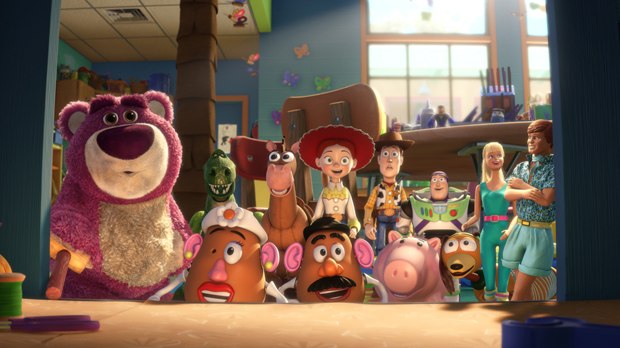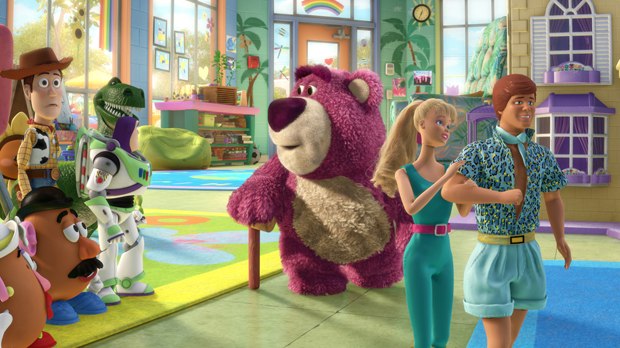Read how Pixar tackled unifying the past and present in Toy Story 3.
Check out the Toy Story 3 trailers and clips at AWNtv!
In the years since we made the first Toy Story, we've all gotten a little older, and hopefully a little wiser. We've experienced many life-cycle events: graduations, weddings, births, and funerals. But one thing we have all retained is a childlike sense of wonder -- as well as the firm belief that when we're not around our toys really do come to life.
-- Lee Unkrich (Foreward to The Art of Toy Story 3 by Charles Solomon from Chronicle Books)
The biggest challenge of Toy Story 3 -- for both Pixar and the characters -- was unifying past and present and accepting the inevitability of change.
"We wanted the film to feel like a Toy Story film but look every bit as gorgeous as anything we've done recently," explains Toy Story 3 director Lee Unkrich. "In the end, we just hued very close to the design grammar of Toy Story in terms of how characters and sets and props were caricatured, but just made everything more visually rich: the lighting is more sophisticated, the texturing is much more sophisticated. We studied the early films and what made up the essence of movement for every character -- what defined them. We didn't stick to them completely because some of the animation we did on the earlier films is not as smooth or subtle, but if you step back a minute, Buzz is still Buzz. Woody is a rag doll and moves the same way-- it's Woody. I think if you play the films side-by-side, you can see the differences. You can see how we've advanced. You can definitely see the progression, but if you watch Toy Story 3 on its own without having watched the others, unless you're a real animation aficionado, I challenge anyone to know that it feels any different at all. It should just feel like a Toy Story film."
The primary responsibility for that rested with Guido Quaroni, the supervising TD who worked on Toy Story 2 as a modeler and shading artist. He suggests the first order of business was rebuilding the original toys from scratch.

Woody must finally confront a world without Andy. Concept art by Glenn Kim from The Art of Toy Story 3 by Charles Solomon (Chronicle Books).
"But the advantage was we had the best designs of the originals from Toy Story 2," Quaroni suggests. "We made it loadable and then we remodeled, re-shaded and re-articulated the [old models] while always matching poses from Toy Story 2. At times you could tell the difference: the shading was better, there was less intersection, better expression on the face because it was denser or had a lot more points."
Quaroni tells a funny story about the new and old Buzz. While comparing models in an early review, John Lasseter pointed out that the new Buzz was wrong-- he was smaller. However, Quaroni insisted they were the same. Turns out that the data was not stored properly, so, during the conversion, there was a tiny scale adjustment of 0.5%.
"It was interesting how vivid in memory those characters are to John," Quaroni adds. "We did certain things better. Some decisions may have not been technically correct back then but somehow made sense. We changed a few things in the characters. If you look at Bullseye's legs in Toy Story 2, they're pretty square. But now they're more rounded because John said he never liked the square ones. We told him it was too complicated to fix back then but [he gave his blessing to fix it]."
The biggest noticeable improvement on Toy Story 3 is subsurface scattering, which began on Ratatouille. "Plastic, until now, never had subsurface," the supervising TD continues. "But, actually, soft plastic, like the vinyl on Woody and Buzz's faces, will have some sub scattering because they're not super hard. Light can travel inside and go out -- it's not like a total reflective surface. So we had a little bit of that and you see more softness on their new skin. With backlighting and subsurface, we have this ability to pretend that this surface doesn't stop right at the most outer shell. You get a sense of depth."
In fact, Toy Story 3 benefited from incremental advancements over the last few years. Still, comparing Big Baby to Billy from Tin Toy, offers a world of difference.
But Lotso, the pink, plush bear and leader of the toys at Sunnyside daycare, was definitely the most challenging new character. A few years ago, without global illumination, Lotso would've been unthinkable. (He actually predates Toy Story when the project was first proposed as a Christmas special starring Tinny from Tin Toy.)
"Hair [or fur] was another one of those incremental improvements to be able to handle the challenge of Lotso," Quaroni offers. "We wanted to be able to put out a lot more hairs with thinner and fuzzy and interesting properties. In the end, it didn't matter how much hair Lotso has: it was more about increasing the performance and making the toolset easier for the person using it to be able to see the individual pieces.
"When you look at Andy, there are 30 different patches of hair that are managed separately and then assembled together. But the more you have, the more complicated it gets. Sometimes people stop adding more because it gets unmanageable. So we tried to improve the management of all the layers to do more layers and add more detail.
"Shading and lighting for hair were improved as well. When you put Lotso in a scene, he comes in with 16 lights shining on his hair to give it the proper sense of depth and richness. Then there is a global control that changes how the lights behave based on the environment. They are meant to give you a natural look to his plush hair, with all the shadowing. The most time was spent with Lotso."
Cloth improvement was another consideration, especially given the importance of Ken's wardrobe, so Pixar utilized a new modeling and simulation system. "For us, it was about doing more without hampering the director and the story department," Quaroni notes. "We wanted to be able to build every cloth garment that we like. We created a completely new system that made the creation of cloth as friendly as creating anything else. Before Up, cloth was about tailoring. You built the actual cloth pieces as flat elements. You have to put all the stitching, you have to connect it together and then relax it over the body to make it realistic. And that was a very time consuming process.
"So for the new system we actually built a 3D model in place so we don't have to do all the cutting and original panels. And then the modeler figures out how to take it and unfold it back out to then prepare the actual cloth for simulation because the simulator really has to know where the stitches are or where the areas are with more or less thickness, so that he can do more realistic simulation. We did a lot of development to assist the modeling people. And today we have a lot more people that can use cloth. Our goal was to have every modeler (30 or 40 people) to do cloth. As long as they have a good eye for proportions in 3D, the system will do the rest."
Of course, the other noticeable improvement was with the human characters, especially Andy, who is now 17, his mother and Bonnie, a new kid with her own collection of marvelous toys.
"Lee wanted to definitely improve the quality of our humans, so we did a lot of work with the modeling, rigging and shading of our humans," Quaroni adds. " For us, what's really important is to hit certain expressions, emotional moments."
Even Unkrich admits that humans were a weak part of the first two Toy Story films and that there had to be a tidal shift in Toy Story 3. "I knew that if we were going to tell this story and end the film the way we were planning on ending it, they had to be great," Unkrich adds. "You had to see the souls behind the eyes. And they needed to be appealing and the performances needed to be subtle and nuanced."
Not surprisingly, Andy was a long process. "We rebuilt young Andy for the golden age sequence," Quaroni admits. "We couldn't stand the old Andy -- but we figured the audience would understand. You might not realize this but every model we build is perfectly symmetric. It's much easier to build one side and reflect everything to do the work once. And then as soon as the model is loaded into the system, we apply certain animation controls to break it up so you never see a face, even when in the rest pose, is perfectly matching. That's a big struggle when sculpting Big Baby or Andy."
Unkrich says they talked a long time about how to make the final scene work between the humans so that it would be believable and stirring. "What you see in the film is the end result of an enormous amount of work on the part of designers, modelers, animators, lighters, all across the board," Unkrich reflects.
"It closes the circle nicely," Quaroni observes.
Bill Desowitz is senior editor of AWN & VFXWorld.











